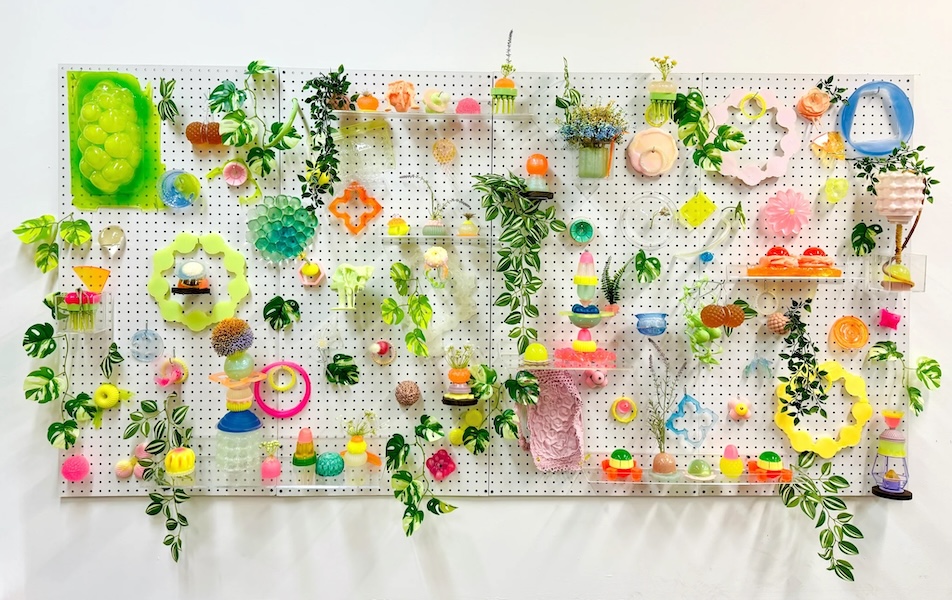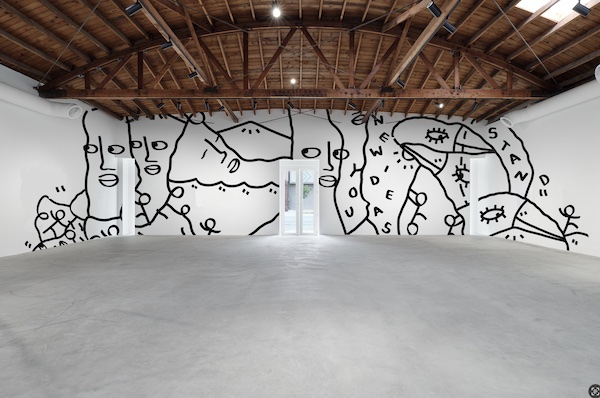In the heart of downtown Los Angeles, a dynamic architectural marvel stands tall, housing two distinctive hotel brands seamlessly integrated into a single structure. The Moxy Hotel DTLA and AC Hotel DTLA, developed by the renowned real estate firm Lightstone, showcase a unique collaboration with the visionary design expertise of Yabu Pushelberg. This innovative pairing brings together the spirited and contemporary atmosphere of Moxy with the timeless sophistication of AC Hotels, offering guests an unparalleled hospitality experience throughout all 727 rooms and 12 food and beverage outlets.

AC Library at AC Hotel DTLA, courtesy of AC Hotel DTLA.
Architecture and Design Harmony
The architectural brilliance and location of the structure are testaments to the meticulous planning and execution by Lightstone. Located across from Cryto Arena and the Los Angeles Convention Center, the shared building provides a striking visual appeal in the downtown skyline, blending modern aesthetics with a touch of classic elegance, offering guests the best of both worlds.
For the interiors, Yabu Pushelberg masterfully crafted spaces that exude luxury and comfort, and mirror each brand’s ethos. Weaving through the shared spaces and individual hotel areas, the design language of the acclaimed firm is quintessential—art-adorned walls, an emphasis on material and texture, intimate nooks and lighting, and a gorgeous balance of sharp, soft, light, and dark. With this cohesive and visually stimulating environment, the thoughtful interiors reflect a careful balance between the playful, vibrant energy of Moxy and the refined, sophisticated ambiance of AC Hotel.
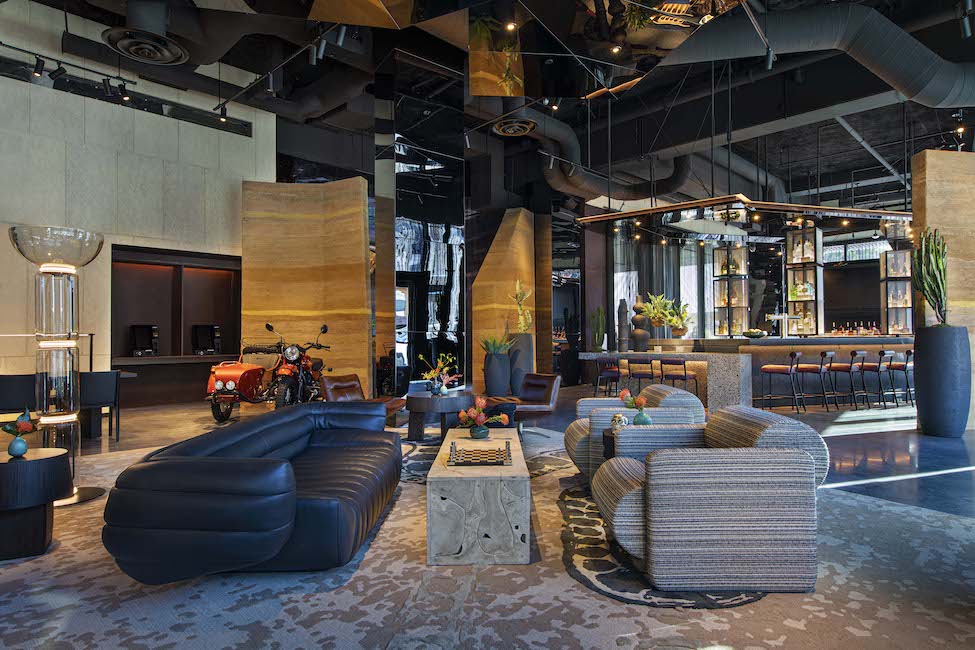
Moxy Lobby Lounge at Moxy Hotel DTLA, courtesy of Moxy Hotel DTLA.
Moxy Hotel DTLA: Playful Atmospheres and Urban Charm
Moxy, known for its contemporary and vibrant approach to hospitality, brings a fresh perspective to downtown LA. The hotel’s design embraces a playful aesthetic, incorporating bold colors, modern furnishings, and interactive spaces. The lobby, adorned with unique art installations and flexible seating arrangements, sets the tone for an engaging atmosphere. Upstairs, guest rooms at Moxy are designed with a focus on efficiency, offering a smart use of space without compromising on style.
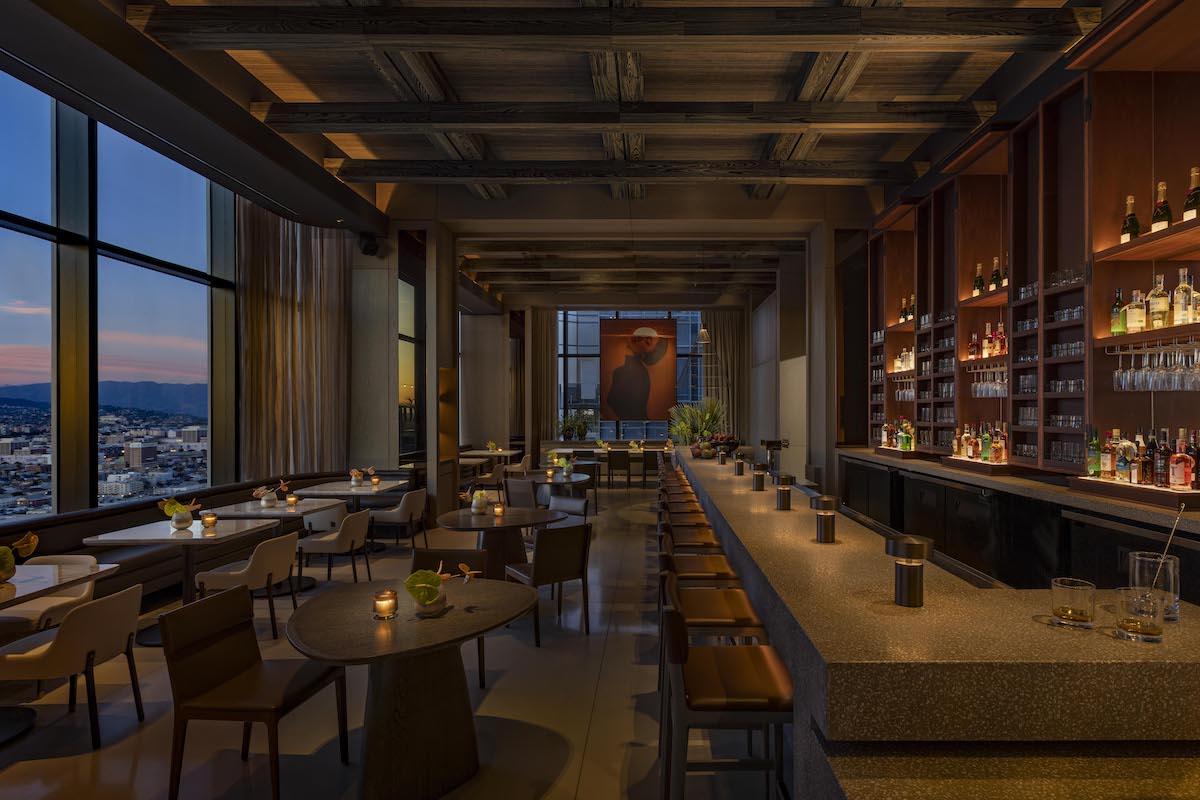
AC Bar at AC Hotel DTLA, courtesy of AC Hotel DTLA.
AC Hotel DTLA: Timeless Elegance and Modern Comfort
In contrast, the AC Hotel DTLA, with its roots in the European design philosophy, radiates timeless elegance. The lobby welcomes guests with a sophisticated ambiance, featuring sleek lines, refined textures, and curated artworks galore—including a large-scale print by Aykut Aydoğdu in the AC Sky Lounge, a wall sculpture by Julie Jenkinson in Moxy Lobby Lounge, and wooden totems by Dennis Lin in AC The Satellite Lobby.
Additionally, the guest rooms, library, bar, and La Lo La Rooftop bar are designed for tranquility and relaxation, with a minimalist aesthetic that emphasizes modern comfort, perfect for guests and locals looking to unwind in style.
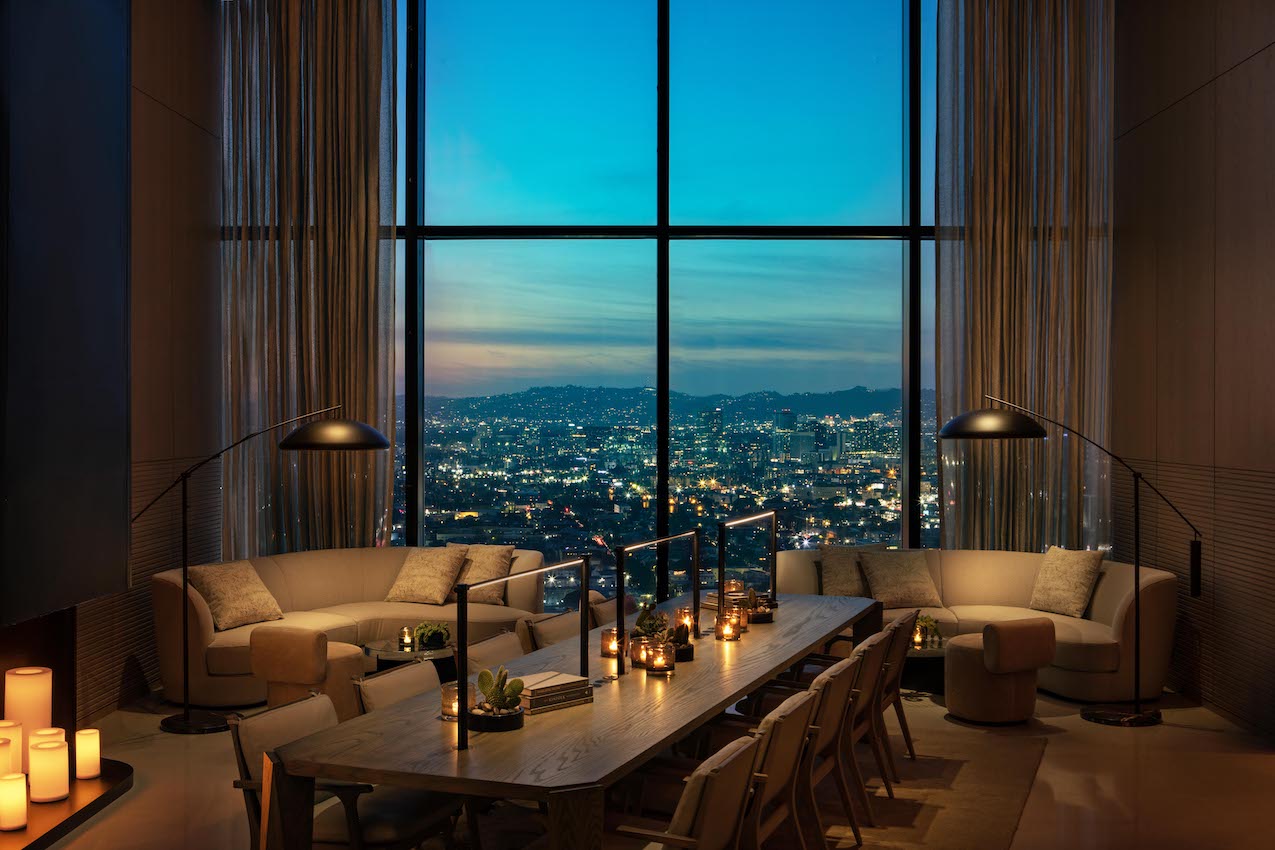
AC Library at AC Hotel DTLA, courtesy of AC Hotel DTLA.
Excellence in Collaboration
The collaboration between Lightstone and Yabu Pushelberg has resulted in a seamless integration of two distinct hotel brands, each with its own personality, within a shared space. Here, guests can transition effortlessly between the lively energy of Moxy and the refined sophistication of AC Hotel while staying geographically central to major events in the area. The resulting property has redefined the concept of coexisting hospitality experiences, and reinvigorated the cultural fabric with art, cultural programming, sumptuous cuisine, decadent design, and more.
George Yabu and Glenn Pushelberg of Yabu Pushelberg, as well as Mitchell Hochberg, President of Lightstone, shared with Whitewall how the innovative collaboration stands as a testament to the evolution of hotel design, setting a new standard for luxury and creativity in downtown Los Angeles.
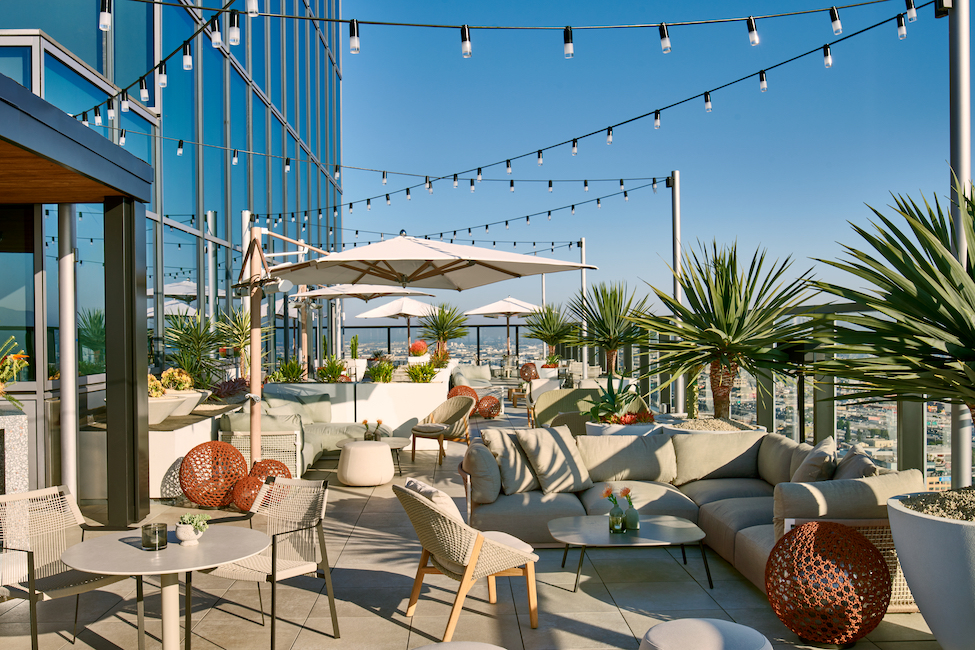
La Lo La Rooftop, photo by Michael Mundy.
WHITEWALL: This property is unique, as it’s a joining of two hotels. What were some of the challenges of creating one property with two identities?
MITCHELL HOCHBERG: Designing a property that blends two different hotel brands was a challenging yet unique task. Rather than creating hotels that compete with one another, we made them compatible with each other. Through Moxy and AC, we were able to cater to both business travelers attending conferences and adventurous nomads looking to explore DTLA’s renaissance. We partnered with Yabu Pushelberg for the interior design. Our task was to create separate personalities for each hotel while maintaining a cohesive property. Moxy DTLA channels the adventurous spirit of the California desert with a sexy and irreverent design, while AC embodies a refined, artistic ambiance, blending its Spanish heritage with LA’s Latin influence. In the end, we successfully merged two hotel experiences under one roof, providing guests with the choice to immerse themselves in different atmospheres while enjoying a shared, vibrant destination.
WW: Each brand has its own DNA. How did you highlight each, yet create cohesion in common spaces?
MH: Each brand’s distinctive DNA while creating cohesion in common spaces was a pivotal part of our vision. We were heavily inspired by California, highlighting the aesthetic of Moxy’s desert nomad and AC’s artist’s residence feel. We recognized that the hotels needed to reflect their location—just as Lightstone’s other Moxy projects retain a specific, hyper-local sense of place—while avoiding the typical iconography of palm trees and sunsets. The answer was to focus on another piece of California mythology: the iconoclastic nomad, as epitomized by the cult film Easy Rider. For Moxy DTLA, YP leaned into the idea of adventure and exploration and the sexy allure of the open road. Guestrooms and public spaces reference biker culture, desert reptiles, and the gritty romance of the open road. For AC, YP imagined the hotel as an artist’s loft or studio, and brought the Spanish roots of the AC brand into conversation with the Latin heritage of Los Angeles.
The result is soothing and residential in style, retaining elements of the California desert and of a free-thinking, spirited persona, but the “nomad” has put down roots. Moxy and AC offer two differing hotel experiences within the same space, enabling both travelers and locals to tailor their journey, all while having access to the amenities of the other. This approach allowed us to emphasize the individual character of each brand while fostering a sense of unity in our shared spaces.
WW: How did this location—across from Crypto Arena and near the convention center—play into what the programming needed to offer, such as the number of double beds, suites, F&B outlets, ballrooms, or event spaces?
MH: The location was crucial as we are in close proximity to major event venues such as the LA Convention Center and Crypto.com Arena. We aimed to create a one-of-a-kind destination that complements the events in the surrounding area, inspiring our 7th Floor Meeting Space and Level 8 as a perfect place to work, stay, and play.
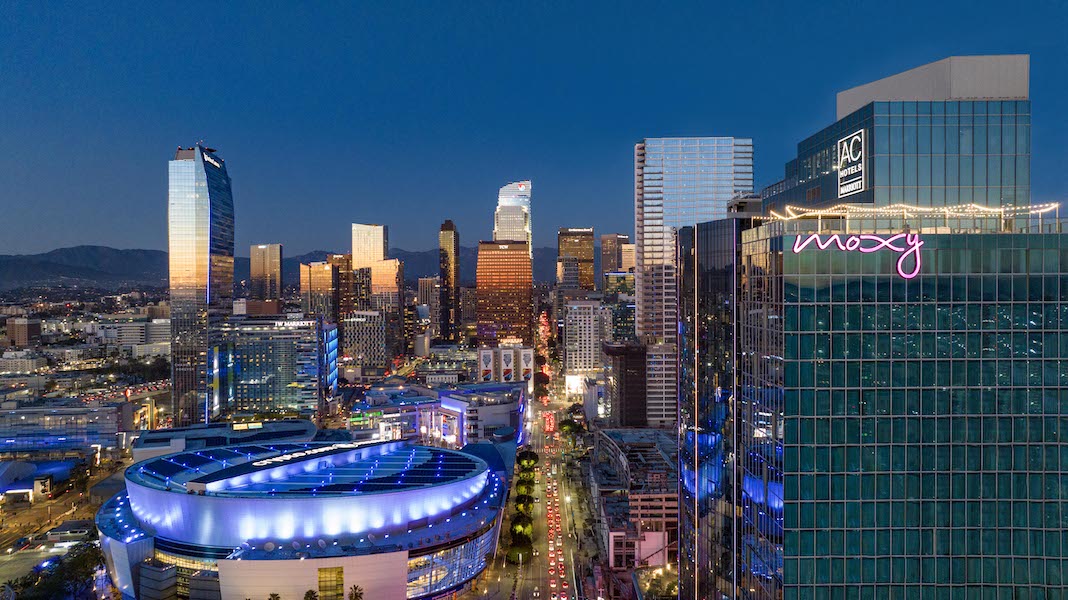
Moxy Hotel DTLA and AC Hotel DTLA, courtesy of the hotels.
WW: Moxy is a rapidly growing brand thanks to your development expertise and expansion. How did you start working with the brand, and evolve into a go-to partner?
MH: Our journey with the Moxy Hotels started eight years ago when we had the vision of adapting it for U.S. gateway cities. At that point, we were searching for a brand partner, and after investing many years studying the hospitality market, we saw an opportunity to create a new type of lifestyle hotel that could provide efficient rooms at an affordable rate without compromising on design. As our ideas evolved, we decided to approach Marriott and form a partnership to bring the Moxy brand to the United States. We have had a long-standing relationship with Marriott, and being the most highly regarded international hotel brand with over 110 million loyalty members, we knew that they would be a valuable asset to our developments as they are the best in the class.
WW: How does this particular property compare to other Moxy hotels you’ve developed?
MH: When comparing this particular property to the other Moxy hotels we’ve developed, it’s important to note that this project offered a challenging opportunity to work on a greater scale and complexity than any of our previous hotels. Our involvement with this project began 8 years ago, culminating in the land acquisition in 2018. While the development process involved challenging entitlement procedures, we had strong confidence in the location. This confidence was driven by its proximity to the convention center, Crypto.com Arena, and the area’s significant surge in residential development. For leisure visitors, Downtown Los Angeles has increasingly become a lively destination over the past decade. The area has experienced an astonishing renaissance in terms of restaurants, nightlife, and cultural offerings. This context sets this Moxy property apart from our previous developments, making it an iconic and exciting addition to our portfolio.

AC Hotel DTLA, courtesy of AC Hotel DTLA.
WW: What are your hopes for its positioning in LA’s landscape—visually, and community-wise?
MH: Our hopes for the positioning of this property in Los Angeles go hand in hand with the dynamic landscape of the city, both visually and in terms of community integration. We intentionally designed the lobbies to be appealing to locals, so guests mix and mingle with Angelenos. People from the community become our best guest amenity and continually come back to visit our bar and restaurants.
Our property in DTLA aligns with this thriving transformation, aiming to become a part of the community fabric. We envision it as a visual and cultural anchor, complementing the thriving Arts District on the eastern edge of downtown, with its galleries, studios, and shops. We aspire for our property to not only contribute to the visual appeal of the area but also to serve as a welcoming and dynamic space where the local community can connect, socialize, and experience the evolving cultural tapestry of DTLA.
WW: Lightstone develops an array of projects—industrial, hospitality, residential. What makes a project enticing to you? When do you know it’s for Lightstone?
MH: Over the last 30-plus years, we’ve grown to become one of the most diversified privately held real estate firms in the United States, with a national portfolio encompassing hospitality, residential, industrial, life sciences, and commercial real estate. When we embark on a new development we are always looking to create something that will give us a competitive edge. We are not afraid to do something groundbreaking that’s new and different. We have upheld our reputation by continuously doing research and listening to our consumers which gives us confidence to do what we do and do it well.
WW: What are you working on now/next?
MH: With today’s high interest we’re taking a pause on new development. But we plan to pursue hospitality, luxury residential (for sale/for rent), and industrial projects in the future.

Bar Moxy at Moxy Hotel DTLA, courtesy of Moxy Hotel DTLA.
Through the Lens of Yabu Pushelberg
WW: This joint property is unique for its layout as a dual hotel. How did you approach designing a space like this, with 2 different aesthetics across over 727 rooms and 12 F&B outlets?
GEORGE YABU: Moxy Downtown Los Angeles has a loose and playful energy while AC Downtown Los Angeles is tailored and refined. Each has its own unique personality and parallel ways of seeing Los Angeles yet are tethered together. They are sisters, not twins, after all. We designed Moxy Times Square and the guestrooms of Moxy Chelsea, so it felt natural to adapt the sensibilities of Moxy to the West Coast. We combined the brand’s distinct and playful ethos with the adventurous spirit of California, conceiving the space through the eyes of a desert nomad. The AC Downtown Los Angeles was designed as an artist’s home. Something that was important to us was to honor the Spanish heritage of the AC brand, so we turned to Spanish architecture to help shape our design approach.
WW: What type of traveler is each hotel for, and how does the design aid this?
GLENN PUSHELBERG: One responds to the extravert and the other responds to the introvert. It’s about what mood the guests choose to channel during their stay. Moxy Downtown Los Angeles interiors are sexy and free-spirited, referencing biker culture, desert reptiles, and the gritty romance of the open road. The AC Downtown Los Angeles is grounded and centered, tailored and refined. This is a place for guests who prefer beauty in its subtlety or are looking for a quiet place to come home to while traveling for business.
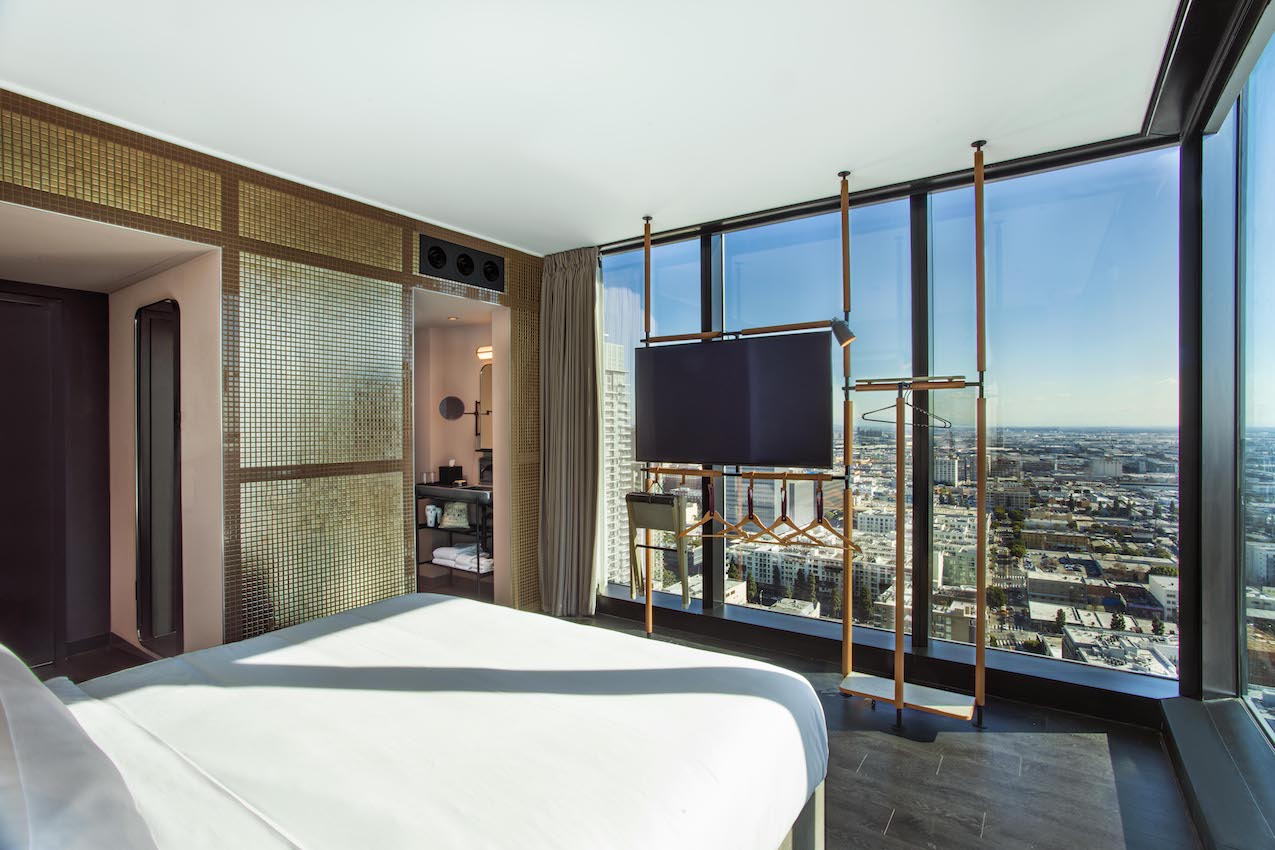
Moxy Hotel DTLA, courtesy of Moxy Hotel DTLA.
WW: Some spaces, like La Lo La, have details inspired by the west coast’s surroundings—like a desert color pallet of sand and white. What surrounding elements in LA became inspirational touchpoints for design? (Terrazzo-clad bar; plantings of palms, cacti, and succulents; seating nooks; bistro lights; oversized umbrellas; etc.) What are some unexpected design details that visitors can explore? Which of these speak to your studio’s DNA?
GY: For DTLA Moxy, we were inspired by the desert wanderer and used materials to tell this story. In the lobby, we use organic materials like rammed earth and wood against mirrored columns, iridescent mosaic tiles, and vibrant art installations to bring this to life. We also do this through an assortment of furniture groupings, playing with colors and textures.
WW: How would you describe your studio’s design ethos, regardless of the project?
GP: We see design as an opportunity to shape experiences that communicate mood. Our goal is for people of all walks of life to enter our environments and feel something. That feeling can and should vary. Drawing from empathy, comfort, allure, and above all, joyfulness, we design projects as worlds of their own to connect to the roots of an individual. The aesthetic of these worlds are extensions of the chosen emotion. Our world begins and ends with feeling.
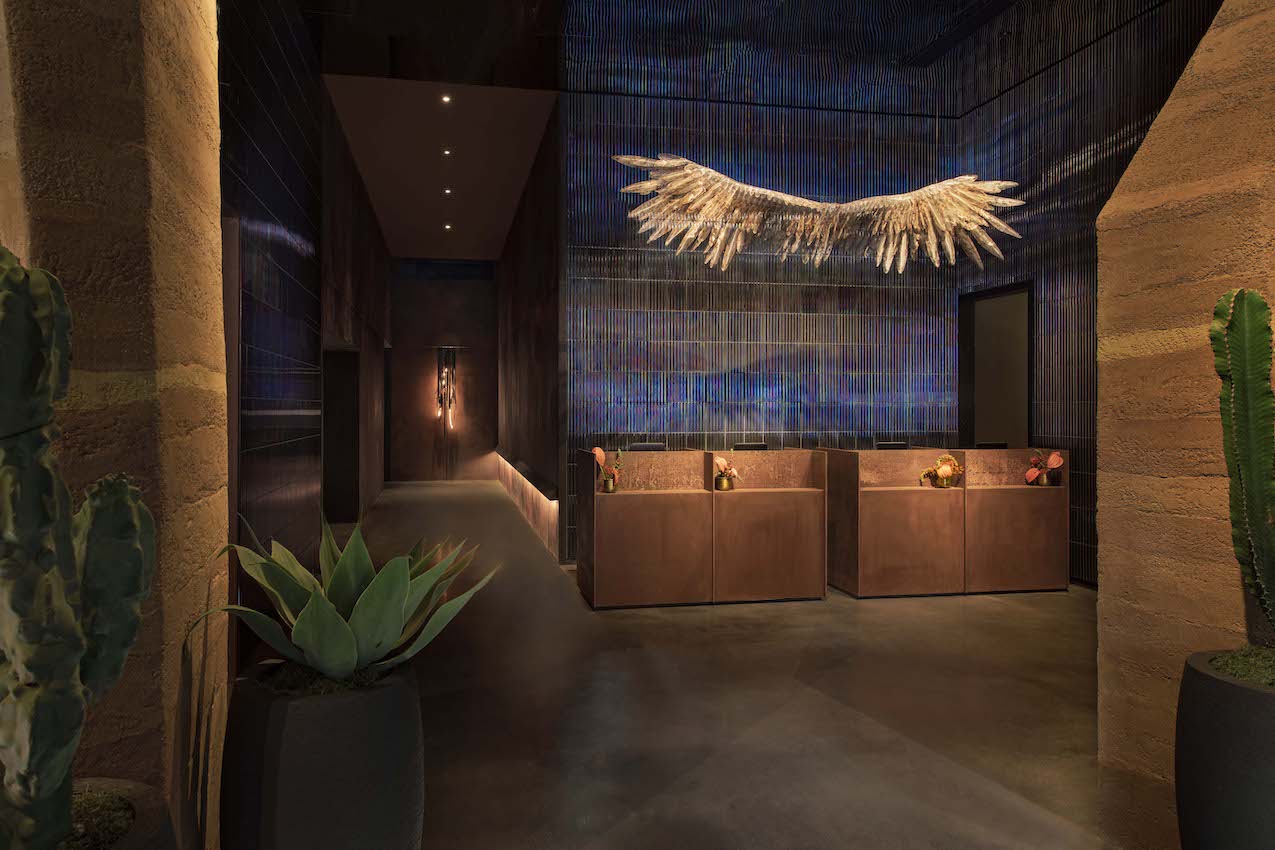
Moxy Hotel DTLA check-in, courtesy of Moxy Hotel DTLA.
WW: How did you approach curating the art for the properties? What fills the spaces?
GY: The goal was to integrate art into the interiors to become one complete experience. Some of our favorite pieces include a large-scale print by Istanbul-based digital artist Aykut Aydoğdu in the AC Sky Lounge, a mixed-media wall sculpture by British artist Julie Jenkinson in Moxy Lobby Lounge, these beautiful sculptural wooden totems by Dennis Lin in AC The Satellite Lobby.
GP: We envisioned La Lo La Rooftop as a beautiful, bountiful Spanish garden. Greenery, mood lighting, and comfortable, functional furniture was our priority. This notion is an extension of the design story we created for AC DTLA, where we crafted a narrative around the life of a visual artist and what their home would look like.
WW: In your Toronto, NYC, and Amagansett homes, as well as your Toronto and NYC work studios, you have art collections filled with names like Andy Warhol, Anish Kapoor, Yayoi Kusuma, Robert Mapplethorpe, Lee Kang-So, Hiroshi Sugimoto, Diane Arbus, Nobuyoshi Araki, Thomas Ruff, and Philip-Lorca diCorcia. Tell us about your collection. Does each space have a theme? Do the works rotate? How many are commissions? What was the first piece? What was your latest acquisition?
GY: To us collecting art is very personal. It’s not about investing or a strategy around a bound collection—it’s just things that we love. We are drawn to what captures our attention in the moment and don’t like to think too hard beyond that. Our art collection reflects our memories, and how our personalities and taste continue to evolve. Something we bought 25 years ago can take on a completely new meaning, resonating with who we are today more than what it meant to us when we initially bought it. That is the beauty of art, it continues to take on new meaning and moves through life with you. What is important to us is to not be precious about it, art is meant to be shared. That is why we have designed a gallery space in both our Toronto and New York studios. Our team can walk through the door every day to pieces from our collection and build their own interpretation and relationship with it. We want to share and have people inspired, it is the only way for us to move forward.
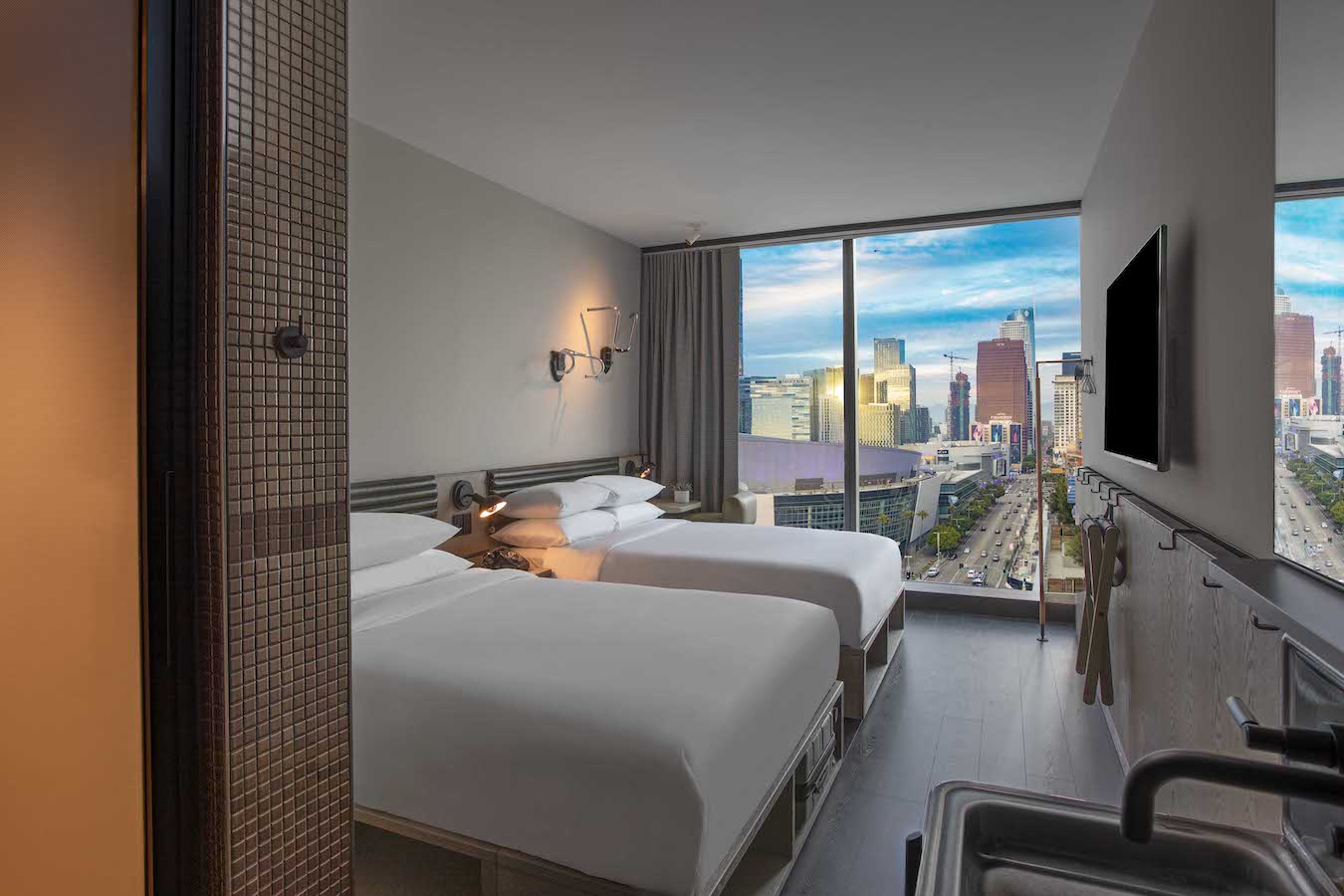
Moxy Hotel DTLA, courtesy of Moxy Hotel DTLA.
WW: What do you like to do when you’re in Los Angeles? Have you recently discovered any new favorite spaces—like shops or restaurants?
GP: No matter where we travel, we roll with the punches. We don’t get out to Los Angeles often as we should, but the last time we spent our downtime visiting Hauser & Wirth, Futures Perfect, and found an incredible Shiro Kuramata illustration book at Dover Street Market.
WW: What are you working on now? Any destinations you have projects in that are particularly exciting?
GY: Tokyo, Berlin, Las Vegas, Mexico, Athens…maybe Lake Como, but you didn’t hear it from us. We completed the design of the Aman Tokyo Residence, marking their first standalone branded residence in the world. It is a milestone moment for Aman and for us. My parents were born and raised in Japan; to be back in the country where I have these deep roots, and now creating a one-of-a-kind project that overlooks the city feels full circle. We are not precious about many things, but with the Aman Tokyo Residence we are. The design encapsulates the future work of our studio and how our team works in flow together. Interiors, stylists, and product designers create space that tells a complete story. In the same Azabudhai Hills neighborhood of Tokyo, we designed an office and retail space for Mori Developments, featuring artwork by Olafur Eliasson.
After the Tokyo openings, we are headed to Berlin for the launch of Moët & Chandon Bar Berlin, a champagne bar located within KaDeWe department store. For this space, we wanted to challenge the notion that champagne is reserved solely for special occasions. Why can’t it be for celebrating the big and small wins of every day?
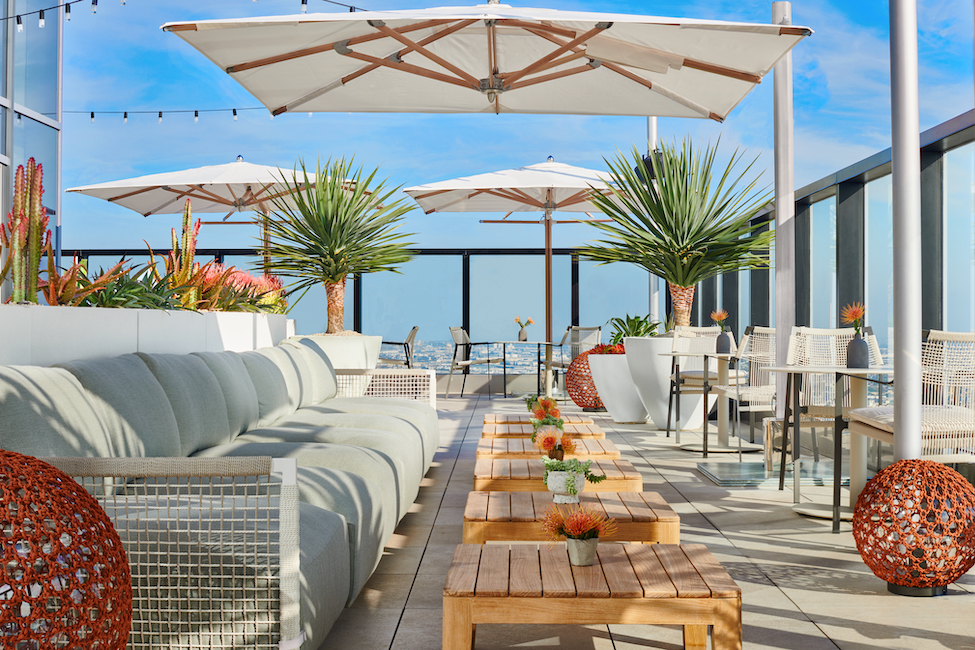
La Lo La Rooftop, photo by Michael Mundy.





